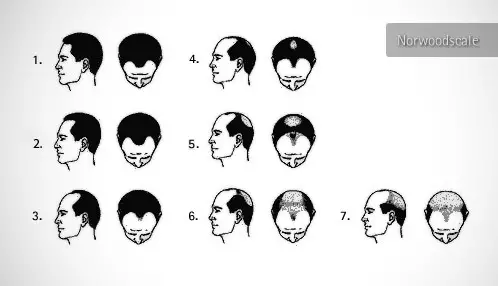Hair loss in men
Male Pattern Baldness
The most common form of hair loss is Male Pattern Baldness (androgynous alopecia). It is caused by the hormone DHT (Dihydrotestosteron) and is acting on genetically sensitive follicles.
Male Pattern Baldness usually affects the front and crown areas of the head, leaving hair at the back and on the sides untouched. Since the hair is not susceptible to DHT in these specific areas, that hair can be transplanted to affected areas without any negative effects from the DHT.
At the Ilter Clinic we know the success of a hair transplant therefore depends on the availability of hair in the donor area and the size of the area to be treated in the recipient area. In addition to that, we always have to take the current condition and characteristics of the hair into consideration. Hair loss might follow certain patterns but each case is always unique, which we at the Ilter Clinic find very important to remember.

The Norwood Scale
As hair loss always varies from person to person, the Norwood Scale created by MD O’Tar Norwood was meant to serve as a guideline for measuring the degree of hair loss in men. By looking at the scale’s categories, we can see approximately how much hair that needs to be transplanted and how much donor hair we have to work with.
Grade 1: The patient has not experienced a substantial amount of hair loss. Hair transplantation is not recommended at this stage.
Grade 2: Men often start losing hair around their temples. This may continue for several years. Once it reaches an advanced stage, hair transplantation is usually recommended.
Grade 3: Patients at this level usually have been affected by hair loss for a few years. Hair transplantation is often recommended.
Grade 4: Hair loss at the temples and an enlarged bald patch on the crown are typical of this grade. A high proportion of patients with Grade 4 hair loss decide to undergo a hair transplant procedure.
Grades 5 & 6: The hair loss has now reached an advanced stage around the temples and on the crown. As in Grade 4, a high proportion of our patients decide to have a hair transplant at this point.
Grade 7: Men with such advanced hair loss can be candidates for a hair transplant, but with such a restricted donor area the transplant may be limited to restoring the hairline while the crown remains bald.
Free consultation for FUE
The Norwood Scale is a handy tool, but here at the Ilter Clinic we believe every head of hair is different, and therefore every solution should be tailored to suit each individual. Consequently, we want to offer our patients a consultation free of charge. During a consultation, we discuss your age, possible hereditary factors, your degree of hair loss, your hair type and structure and your amount and quality of donor hair. Not until we sit down and discuss these factors with a patient, we can decide if an FUE Ilter Method procedure is necessary and suitable. If it is, then we can start preparing your treatment plan.

